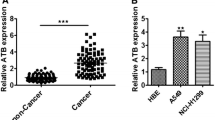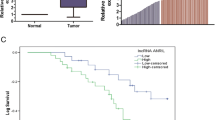Abstract
Long non-coding RNAs (lncRNAs) have been proved to serve as a critical role in cancer development and progression. However, little is known about the pathological role of lncRNA metastasis-associated lung adenocarcinoma transcript 1 (MALAT1) in pancreatic cancer patients. The aims of this study are to measure the expression of lncRNA MALAT1 in pancreatic cancer patients and to explore the clinical significance of the lncRNA MALAT1. Using qRT-PCR, the expression of lncRNA MALAT1 was measured in 126 pancreatic cancer tissues and 15 adjacent non-cancerous tissues. In the present study, our results indicated that lncRNA MALAT1 was highly expressed in pancreatic cancer compared with adjacent non-cancerous tissues (P < 0.001), and positively correlated with clinical stage (early stages vs. advanced stages, P < 0.001), tumor size (<2 vs. ≥2 cm, P = 0.004), lymph node metastasis (negative vs. positive, P < 0.001), and distant metastasis (absent vs. present, P = 0.001) in pancreatic cancer patients. Furthermore, we also found that lncRNA MALAT1 overexpression was an unfavorable prognostic factor in pancreatic cancer patients (P < 0.001), regardless of clinical stage, tumor size, lymph node metastasis, and distant metastasis. Finally, increased lncRNA MALAT1 expression was an independent poor prognostic factor for pancreatic patients through multivariate analysis (P = 0.018). In conclusion, overexpression of lncRNA MALAT1 serves as an unfavorable prognostic biomarker in pancreatic cancer patients.


Similar content being viewed by others
References
Siegel R, Ma J, Zou Z, Jemal A. Cancer statistics, 2014. CA: Cancer J Clin. 2014;64(1):9–29. doi:10.3322/caac.21208.
Guo X, Cui Z. Current diagnosis and treatment of pancreatic cancer in China. Pancreas. 2005;31(1):13–22.
Chen Y, Hao J, Ma W, Tang Y, Gao C, Hao X. Improvement in treatment and outcome of pancreatic ductal adenocarcinoma in north China. J Gastrointest Surg: Off J Soc Surg Aliment Tract. 2011;15(6):1026–34. doi:10.1007/s11605-011-1493-y.
Stathis A, Moore MJ. Advanced pancreatic carcinoma: current treatment and future challenges. Nat Rev Clin Oncol. 2010;7(3):163–72. doi:10.1038/nrclinonc.2009.236.
Sharma C, Eltawil KM, Renfrew PD, Walsh MJ, Molinari M. Advances in diagnosis, treatment and palliation of pancreatic carcinoma: 1990–2010. World J Gastroenterol: WJG. 2011;17(7):867–97. doi:10.3748/wjg.v17.i7.867.
Yang G, Lu X, Yuan L. LncRNA: a link between RNA and cancer. Biochim Biophys Acta. 2014;1839(11):1097–109. doi:10.1016/j.bbagrm.2014.08.012.
Mattick JS. The genetic signatures of noncoding RNAs. PLoS Genet. 2009;5(4):e1000459. doi:10.1371/journal.pgen.1000459.
Tahira AC, Kubrusly MS, Faria MF, Dazzani B, Fonseca RS, Maracaja-Coutinho V, et al. Long noncoding intronic RNAs are differentially expressed in primary and metastatic pancreatic cancer. Mol Cancer. 2011;10:141. doi:10.1186/1476-4598-10-141.
Sun YW, Chen YF, Li J, Huo YM, Liu DJ, Hua R, et al. A novel long non-coding RNA ENST00000480739 suppresses tumour cell invasion by regulating OS-9 and HIF-1alpha in pancreatic ductal adenocarcinoma. Br J Cancer. 2014. doi:10.1038/bjc.2014.520.
Ma C, Nong K, Zhu H, Wang W, Huang X, Yuan Z, et al. H19 promotes pancreatic cancer metastasis by derepressing let-7′s suppression on its target HMGA2-mediated EMT. Tumour Biol: J Int Soc Oncodev Biol Med. 2014;35(9):9163–9. doi:10.1007/s13277-014-2185-5.
Kim K, Jutooru I, Chadalapaka G, Johnson G, Frank J, Burghardt R, et al. HOTAIR is a negative prognostic factor and exhibits pro-oncogenic activity in pancreatic cancer. Oncogene. 2013;32(13):1616–25. doi:10.1038/onc.2012.193.
Gutschner T, Hammerle M, Diederichs S. MALAT1—a paradigm for long noncoding RNA function in cancer. J Mol Med (Berlin, Germany). 2013;91(7):791–801. doi:10.1007/s00109-013-1028-y.
Ji P, Diederichs S, Wang W, Boing S, Metzger R, Schneider PM, et al. MALAT-1, a novel noncoding RNA, and thymosin beta4 predict metastasis and survival in early-stage non-small cell lung cancer. Oncogene. 2003;22(39):8031–41. doi:10.1038/sj.onc.1206928.
Schmidt LH, Spieker T, Koschmieder S, Schaffers S, Humberg J, Jungen D, et al. The long noncoding MALAT-1 RNA indicates a poor prognosis in non-small cell lung cancer and induces migration and tumor growth. J Thorac Oncol: Off Publ Int Assoc Study Lung Cancer. 2011;6(12):1984–92. doi:10.1097/JTO.0b013e3182307eac.
Han Y, Liu Y, Nie L, Gui Y, Cai Z. Inducing cell proliferation inhibition, apoptosis, and motility reduction by silencing long noncoding ribonucleic acid metastasis-associated lung adenocarcinoma transcript 1 in urothelial carcinoma of the bladder. Urology. 2013;81(1):209 e201–207. doi:10.1016/j.urology.2012.08.044.
Ying L, Chen Q, Wang Y, Zhou Z, Huang Y, Qiu F. Upregulated MALAT-1 contributes to bladder cancer cell migration by inducing epithelial-to-mesenchymal transition. Mol BioSyst. 2012;8(9):2289–94. doi:10.1039/c2mb25070e.
Lin R, Maeda S, Liu C, Karin M, Edgington TS. A large noncoding RNA is a marker for murine hepatocellular carcinomas and a spectrum of human carcinomas. Oncogene. 2007;26(6):851–8. doi:10.1038/sj.onc.1209846.
Luo JH, Ren B, Keryanov S, Tseng GC, Rao UN, Monga SP, et al. Transcriptomic and genomic analysis of human hepatocellular carcinomas and hepatoblastomas. Hepatology (Baltim, Md). 2006;44(4):1012–24. doi:10.1002/hep.21328.
Fellenberg J, Bernd L, Delling G, Witte D, Zahlten-Hinguranage A. Prognostic significance of drug-regulated genes in high-grade osteosarcoma. Mod Pathol: Off J U S Can Acad Pathol Inc. 2007;20(10):1085–94. doi:10.1038/modpathol.3800937.
Jiao F, Hu H, Yuan C, Wang L, Jiang W, Jin Z, et al. Elevated expression level of long noncoding RNA MALAT-1 facilitates cell growth, migration and invasion in pancreatic cancer. Oncol Rep. 2014;32(6):2485–92. doi:10.3892/or.2014.3518.
Motoyama K, Inoue H, Nakamura Y, Uetake H, Sugihara K, Mori M. Clinical significance of high mobility group A2 in human gastric cancer and its relationship to let-7 microRNA family. Clin Cancer Res: Off J Am Assoc Cancer Res. 2008;14(8):2334–40. doi:10.1158/1078-0432.ccr-07-4667.
Kung JT, Colognori D, Lee JT. Long noncoding RNAs: past, present, and future. Genetics. 2013;193(3):651–69. doi:10.1534/genetics.112.146704.
Maruyama R, Suzuki H. Long noncoding RNA involvement in cancer. BMB Rep. 2012;45(11):604–11.
Liu JH, Chen G, Dang YW, Li CJ, Luo DZ. Expression and prognostic significance of lncRNA MALAT1 in pancreatic cancer tissues. Asian Pac J Cancer Prev: APJCP. 2014;15(7):2971–7.
Lai MC, Yang Z, Zhou L, Zhu QQ, Xie HY, Zhang F, et al. Long non-coding RNA MALAT-1 overexpression predicts tumor recurrence of hepatocellular carcinoma after liver transplantation. Med Oncol (Northwood, London, England). 2012;29(3):1810–6. doi:10.1007/s12032-011-0004-z.
Conflicts of interest
None
Author information
Authors and Affiliations
Corresponding author
Additional information
Er-Jun Pang and Rui Yang contributed equally to this work.
Rights and permissions
About this article
Cite this article
Pang, EJ., Yang, R., Fu, Xb. et al. Overexpression of long non-coding RNA MALAT1 is correlated with clinical progression and unfavorable prognosis in pancreatic cancer. Tumor Biol. 36, 2403–2407 (2015). https://doi.org/10.1007/s13277-014-2850-8
Received:
Accepted:
Published:
Issue Date:
DOI: https://doi.org/10.1007/s13277-014-2850-8




